Vernonia amygdalina (Bitter Leaf): A Natural Remedy for Diabetes Mellitus and its Complications
Introduction
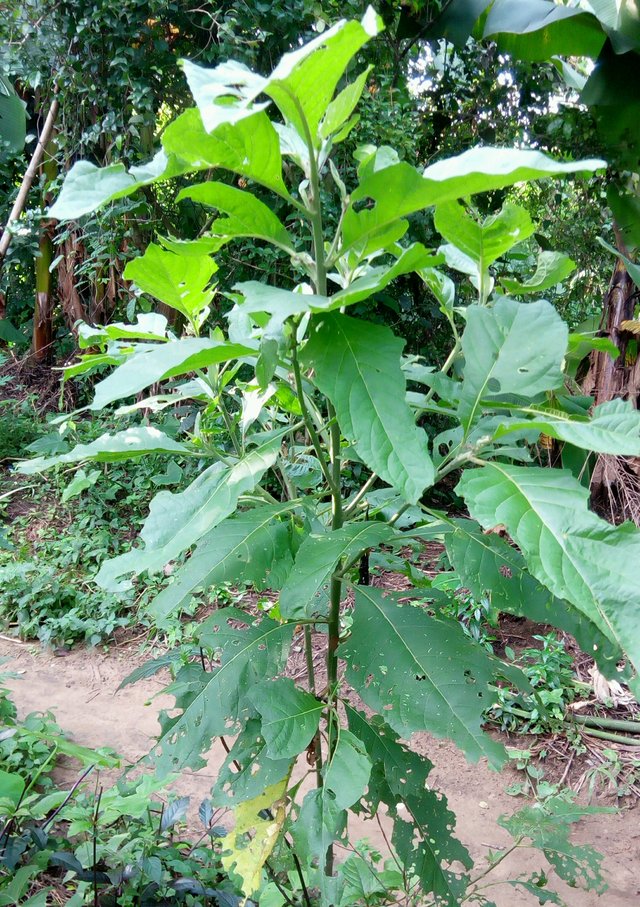 In the tropical Africa lies the cheapest and most effective remedy for diabetes mellitus [Author: Picture taken by me]
In the tropical Africa lies the cheapest and most effective remedy for diabetes mellitus [Author: Picture taken by me] When considering the world's most dangerous diseases; diabetes mellitus happens to be one of them. I really do not understand why diabetes is not yet regarded as an epidemic despite the increased mortality rate associated with it. Maybe the center for disease control (CDC) wants all of us to die first before they realize that diabetes is a serious threat to human existence. Back to the issue at hand; unfortunately, even with the overwhelming scientific advances; inability to establish an effective modern therapeutic approach for preventing or treating diabetes mellitus over the years has worsened the situation.
The shocking thing about diabetes mellitus is that, the media don't seem to be bothered by the increased mortality rate. At the same time, regardless of the poor publicity, the term generally is still a well-known word among the young and old. There's literally no one who has not heard of diabetes, though most people don't really know what it entails. However, few learned persons believe that one can only be diabetic if they consume excess of sugary food substances.
Actually, the above idea to an extent is valid. Nevertheless, it is definitely not the basis in most cases of diabetes mellitus. As we move ahead we'll understand why it's not considered as the basis. For clarity purpose, it's worthy of note that diabetes mellitus is mainly caused by metabolic disorders. It's the metabolic disorders that trigger increase in blood sugar level after a long period of time.
Furthermore, the increased blood sugar level will in turn develop numerous complications that may alter the normal functions of some of the vital body organs. Hence, the major aim of this article is to pinpoint how bitter leaf, a readily available plant in the tropical Africa help in preventing this disease condition (diabetes). Also, for persons that are already diabetic, this article showcases how the plant intervenes in cases of complications.
What you should know about diabetes mellitus
.jpg) For so many people, diabetes mellitus is only a 'sweet' disease. (License: CC BY-SA 3.0, Author: Tony Hisgett]: Wiki Commons
For so many people, diabetes mellitus is only a 'sweet' disease. (License: CC BY-SA 3.0, Author: Tony Hisgett]: Wiki CommonsTake few seconds and imagine a world without diabetes. I guess life would have been more fun, but this very disease is ruining it. Most of us were denied candies, ice creams, cakes, etc, because dad and mom believed that those sweet things will make one diabetic. Personally, while growing up, the term diabetes was the worst word for me. Any demand for something that's sweet will always meet with this saying, "you can't eat that so you won't have diabetes".
However, the truth is, not everyone become diabetic even with the too much of sugary food consumption. Also, quite a number of people that are diabetic don't even consume much sugary food substances compared to those that are not diabetic. Nevertheless, even though consumption of sugary food is not the primary cause of diabetes; presence of metabolic disorders in an individual that take sweet foods or too much of carbohydrates will immediately turn on the disease condition.
Consequently, for one to be able to understand diabetes mellitus, one must first of all understand metabolic disorders. The reason why metabolic disorder is essential in the study of diabetes is that, it goes a long way to explain the fact that consumption of sweet or sugary food is not the basis for diabetes mellitus contrary to popular belief. If sugar consumption was entirely the basis for diabetes, then the full population of the world would have been diabetic by now since there's virtually no food currently that does not contain sugar.
It might interest you to know that metabolic disorders occur due to inborn errors that directly alter normal metabolic processes. It's considered as an inborn error because individuals inherit defective gene instead of the right gene that codes for a corresponding enzyme responsible for a crucial reaction step in metabolism of food substances. Since a defective gene is inherited, there will be enzyme deficiency which will completely change the metabolic processes from the normal to the abnormal. Also, aside from presence of inherited defective gene, inability of the pancreas to function well likewise leads to metabolic disorders.
How pancreas malfunctioning trigger diabetes mellitus
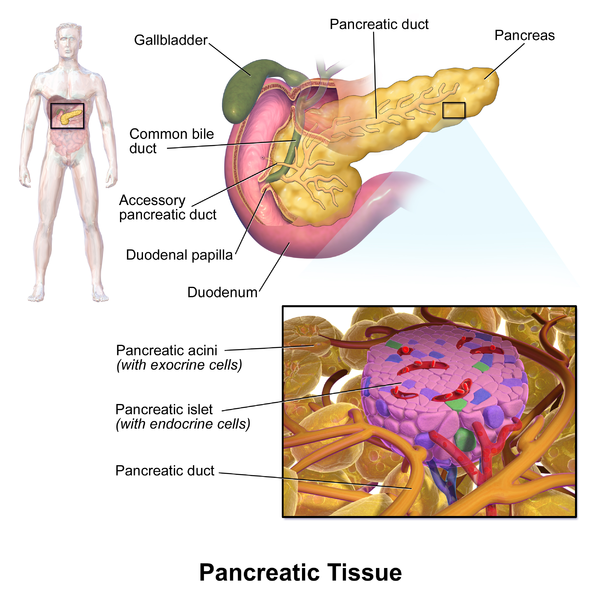 The endocrine and exocrine pancreas (License: CC BY-SA 3.0, Author: BruceBlaus]: Wikipedia Commons
The endocrine and exocrine pancreas (License: CC BY-SA 3.0, Author: BruceBlaus]: Wikipedia CommonsThe pancreas is one body organ that's so important in the metabolism of food substances. The internal parts are unique in the sense that it secrete hormones. On the other hand, the external parts perform digestive functions by secreting digestive enzymes and juices. However, we'll only consider the malfunctioning of the internal (endocrine) parts because it's the major link to metabolic disorders that results in diabetes.
It's worthy of note that millions of cells are present in the internal region of the pancreas. However, despite the fact that these cells are so many; they're categorized into four (4) main types:
• Alpha cells
• Beta cells
• Delta cells
• Gamma cells
Each of these cell types secretes a particular hormone that's different from the others. Alpha cells are responsible for secretion of glucagon, while beta cells aid in insulin secretion. Also, delta cells secrete somatostatin, while gamma cells secrete pancreatic polypeptides. Nevertheless, though the cells release four (4) different types of hormones; they collectively regulate blood sugar level.
When the sugar level is too low in the blood, alpha cells are activated to release glucagon. Correspondingly, when there's increased sugar level in the blood, this stimulates the beta cells to secrete insulin. The delta cells and gamma cells also play supportive role by suppressing or regulating the release of either glucagon or insulin. With these different cell types functioning very well, glucose balance can be maintained. However, for whatsoever reasons, if any of these cells should malfunction, metabolic processes will be affected thereby resulting in metabolic disorder. In this case, the metabolic disorder we are considering is diabetes mellitus which is as a result of failure in beta cells to secrete insulin.
Types of diabetes mellitus and how they differ from each other
Unfortunately, since there's little to no media attention on diabetes, most people do not know that there are of different types. Actually, diabetes mellitus is broadly divided into three (3) different types;
- Type 1 diabetes
- Type 2 diabetes
- Gestational diabetes
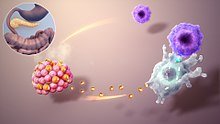 Autoimmune attack in Type 1 diabetes (License: CC BY-SA 3.0, Author: Manu5]: Wikipedia Commons
Autoimmune attack in Type 1 diabetes (License: CC BY-SA 3.0, Author: Manu5]: Wikipedia CommonsIn type 1 diabetes, there's loss in beta cells function of the pancreas; hence insulin cannot be secreted. What could possibly be the reason behind this defect is still uncertain. Scientific researches have shown that what could be a link might be an autoimmune attack on beta cells by T lymphocytes after receiving false signals from dendritic cells. However, others believe it's inherited or caused by environmental factors. Whatever the case may be, since the mechanism that could have prevented excessive increase in blood sugar level is absent, type 1 diabetes is developed. The difference between type 1 diabetes mellitus and the other types of diabetes is that it does not only affect the adults; children also suffer from it.
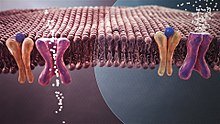 Normal blood glucose absorption (left) and development of resistance by cells resulting in Type 2 diabetes (right) (License: CC BY-SA 3.0, Author: Manu5]: Wikipedia Commons
Normal blood glucose absorption (left) and development of resistance by cells resulting in Type 2 diabetes (right) (License: CC BY-SA 3.0, Author: Manu5]: Wikipedia CommonsWhat makes type 2 diabetes mellitus different from the rest is its level of prevalence. Statistics shows that it's the commonest type of diabetes (among adults). Unlike type 1 diabetes; insulin is secreted in type 2 diabetes, but the secretion is basically too low to the point that tissues in the body start developing resistance to insulin. Tissue resistance to insulin in this context means that the presence of insulin has no significant effect on increased blood glucose level. Lifestyle factors such as obesity, poor diets, and lack of exercise is believed to be the major causes of reduced insulin secretion in type 2 diabetes.
The last on the list is gestational diabetes. It only occur during pregnancy and may disappear after the woman must have given birth. However, in some cases, it goes ahead to develop type 2 diabetes since they share similar mechanism. Gestational diabetes does not only affect the pregnant woman, the unborn child is vulnerable at the same time.
Visible signs and symptoms that prove diabetes mellitus
 Frequent urination; a cause for concern (License: Public Domain]: Pixabay
Frequent urination; a cause for concern (License: Public Domain]: PixabayWhile growing up, I remember people attributing bed wetting at night to diabetes. Funny enough it's just of recent that I understood that bed wetting has little to no connection with diabetes mellitus. The truth is, anyone above three (3) years that's still bed wetting might be suffering from another disease condition and not necessarily diabetes. We'll look at this disease condition in my next article. However let us go back to mentioning the few symptoms associated with diabetes mellitus;
• Frequent urination
• Increased thirst
• Increased hunger
Amongst these symptoms, the only one that stands out is frequent urination. I once lived in a rural area where people mostly urinate in bushes due to low standard of living. The method that these village people used to ascertain if one is suffering from diabetes is amazing. According to them, if one is diabetic, five (5) minutes after urination, ants will be seen clustering around the exact region where the person urinated since the urine will likely have a high sugar content.
Complications associated with diabetes mellitus
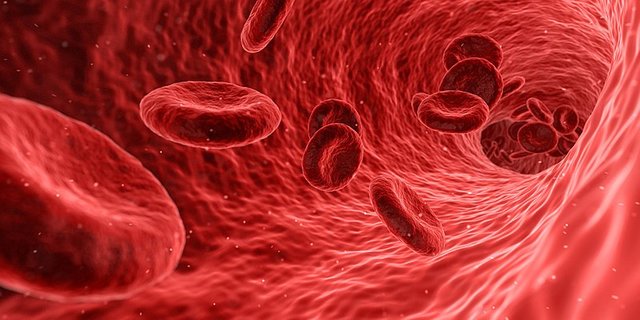 Effect of increased blood sugars on blood vessels (License: CC BY-SA 3.0, Author: Qimono]: Wiki Commons
Effect of increased blood sugars on blood vessels (License: CC BY-SA 3.0, Author: Qimono]: Wiki CommonsTalking about diabetes mellitus without highlighting the numerous complications associated with it may likely not make any sense. Actually what makes diabetes so fatal is the negative effects that increased blood sugars exert on the blood vessels of vital body organs such as the kidneys and the heart. Since these organs are tampered with, overall systems function associated with these organs are also affected. The body systems affected includes;
• Renal system
• Circulatory system
For the renal system, prolonged diabetes causes damage to the filters in the kidney. These filters are made up of blood vessels that are called glomeruli. Since kidney is concerned with removal of waste from blood, the presence of excessive sugars in the blood causes damage to the glomeruli. Once the glomeruli are damaged, waste will begin to accumulate in the body. If waste products should accumulate in the body, we understand that it means the body isn't safe anymore.
Also, blood vessels of the circulatory system which act as transport media are similarly damaged by diabetes. The presence of increased blood sugar causes the blood vessels to constrict or become tighten. The resultant effect of this constriction leads to straining of the heart since blood cannot be effectively pumped to other parts of the body anymore. This may trigger different disease conditions such as high blood pressure, stroke, and heart attack.
What makes bitter leaf consumption effective in prevention and treatment of diabetes mellitus?
Sincerely, it's not as if there is no modern medicine or approach for treatment of diabetes. Though few, but there are different modern approaches towards eradication of diabetes mellitus ranging from pancreas transplant, insulin injection, and anti-diabetic drugs (such as metformin, sulphonylureas, and thiazolidinedione). Aside from the fact that these modern approaches and drugs are expensive and most diabetic patients cannot afford them, there are also accompanied by severe side effects.
Hence, these limitations of modern medicine have paved the way to the emergence of traditional methods for treating life threatening diseases. As a result, there is a rapid increase in the search for remedies from natural products (from plant). This upsurge of interest in traditional medicine is what has actually led to the discovery of anti-diabetic properties in bitter leaf.
The english name 'bitter leaf' given to Vernonia amygdalina is mainly because of its bitter taste. This bitter taste is attributed to its phytochemical content. However, since so many people complain about its taste, thorough washing or boiling of the leaves help in ridding the plant of its bitterness. Researchers have indeed proven that whether the bitter leaf is washed or not, it still possesses its anti-diabetic properties. This has gone a long way to correct certain misconceptions from people who thought that the bitterness was the major constituent of bitter leaf that prevented diabetes.
Truth be told, what really makes consumption of bitter leaf effective is its ability to interfere with important metabolic pathways in the body. These pathways include gluconeogenesis and the pentose phosphate pathway (PPP). Any person that has had knowledge of biochemistry may be surprised why glycolytic pathway is not mentioned here since it is entirely involved in glucose (sugar) breakdown. What happens is that, consumption of bitter leaf will not alter the glycolytic pathway because glucose must be broken down so that cells in the body can make use of it.
Firstly, the main function of gluconeogenesis is to help the body synthesize sugars (glucose) from non-carbohydrate food substances. In diabetic conditions, this pathway is activated so that there will be increased level of blood glucose. Nevertheless, consumption of bitter leaf can help correct this by suppressing gluconeogenesis. Once gluconeogenesis is hindered, the available glucose will only be from carbohydrate food sources.
You will agree with me that recently people tend to consume more and more carbohydrates. You'll still agree with me that these carbohydrates will also be metabolized into excess glucose which may trigger diabetes mellitus. Hence, while suppressing gluconeogenesis, bitter leaf consumption simultaneously makes pentose phosphate pathway more effective. This is because, for the body to be in a healthy condition, it has to somehow oxide the excess glucose. The only pathway responsible for glucose oxidation is the pentose phosphate pathway (PPP). The useful end products obtainable from glucose oxidation include production of NADPH (responsible for countering the damaging effects of oxygen radicals), and Ribose 5-phosphate (a precursor for DNA and RNA).
Summary
What gives treatment with medicinal plants an edge over treatment with modern medicine is the fact that the human body recognizes natural products better and faster than synthetic products. Also, treatments with medicinal plants always have a multi-directional therapeutic approach, whereas modern medicine has a unidirectional therapeutic approach. What this means is that, even though bitter leaf is administered or consumed so as to prevent or treat diabetes and its complications, it can still cure other diseases. For those that hate taking drugs and injections as much as I do, this is our opportunity. As simple as it may be; we can now eradicate diabetes mellitus and live a healthy life by just eating delicious bitter leaf delicacies, or drinking bitter leaf tonic.
References
Effect of diabetes on the renal system. Retrieved on 2nd June, 2018.
Effect of diabetes on the circulatory system. Retrieved on 2nd June, 2018.
Bitter leaf mechanism of action against diabetes. Retrieved on 4th June, 2018.
Ebong, P., Eteng, M., Eyong, E. and Atangwho, I. (2010). Effects of Vernonia amygdalina on kidney function of diabetic rats. International Journal of Pharmacology, 3:143-148
El-Yassin, H. (2012). Biochemistry and disorders of hormones of the pancreas. International Journal of Diabetes mellitus, 3(1):62-69
Nelson, D. and Cox, M. (2011). Principle of Biochemistry, 5th edition. New York: W. H. Freeman and company, page 544-580.
Sembulingam, K. and Sembulingam, P. (2012). Essentials of Medical Physiology, 6th Edition. New Delhi: Jaypee brothers medical publishers Ltd., pp. 301-302.
The Bitter leaf image was taken with my phone camera. All other images are from Pixabay and wikicommons licensed under creative commons and eligible for commercial use.
I'm a member of the steemstem community. We encourage quality posts in the fields of science, technology, engineering and mathematics on the steem blockchain mainly through interaction and engagement. You are most welcomed to join us on discord here
I keep hearing that corn subsidies and the high fructose corn syrup that is made from this crop is very bad for human health. I wonder if the diabetes epidemic is related to this at all?
@procrastilearner Vernonia amygdalina (bitter leaf) is not used in producing high fructose corn syrup but rather it's Zea mays (maize). There are entirely different from each other. While maize is a cereal crop, bitter leaf isn't.
As for the sweetener you mentioned, yeah, high fructose corn syrup is bad for the human health. Thanks for going through the write up.
I almost skipped the question in the last statement you made. As rightly mentioned in the article, diabetes is one disease that's triggered by so many factors. Even the 21st century sedentary life style, excess sugars in almost all the diets you can possibly find on earth, etc. So you see, emergence of high fructose corn syrup is not the only reason. Its only helping to worsen the situation.